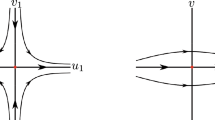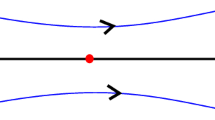Abstract
An equilibrium point p of a differential system in the plane \(\mathbb {R}^2\) is a center if there exists a neighbourhood U of p such that \(U\setminus \{p\}\) is filled with periodic orbits. A difficult classical problem in the qualitative theory of differential systems in the plane \(\mathbb {R}^2\) is the problem of distinguishing between a focus and a center. A global center is a center p such that \(\mathbb {R}^2 \setminus \{p\}\) is filled with periodic orbits. Another difficult problem in the qualitative theory of differential systems in \(\mathbb {R}^2\) is to distinguish inside a family of centers the ones which are global. Lloyd, Pearson and Romanovsky characterized when the origin of coordinates is a center for the family of cubic polynomial differential systems \(\begin{array}{*{20}l} {\dot{x} = y - Cx^{2} + \left( {B + 2D} \right)xy + Cy^{2} + Px^{3} + Gx^{2} y - \left( {H + 3P} \right)xy^{2} + Ky^{3} ,} \hfill \\ {\dot{y} = - x + Dx^{2} + \left( {E + 2C} \right)xy - Dy^{2} - Kx^{3} - \left( {H + 3P} \right)x^{2} y - Gxy^{2} + Py^{3} .} \hfill \\ \end{array}\). Here we characterize when the origin of this family of differential system is a global center.



Similar content being viewed by others
Data availability
Not applicable.
References
Alvarez, M.J., Ferragut, A., Jarque, X.: A survey on the blow up technique. Int. J. Bifurc. Chaos 21, 3103–3118 (2011)
Andronov, A.A., Leontovich, E.A., Gordon, I.I., Maıer, A.G.: Qualitative Theory of Second-order Dynamic Systems. Halsted Press, New York-Toronto (1973)
Andronov, A.A., Leontovich, E.A., Gordon, I.I., Maıer, A.G.: Israel Program for Scientific Translations. John Wiley & Sons, Jerusalem-London (1973)
Artés, J.C., Dumortier, F., Llibre, J.: Qualitative Theory of Planar Differential Systems. Springer, Berlin (2006)
Bautin, N.N.: On the number of limit cycles which appear with the variation of coefficients from an equilibrium position of focus or center type. Mat. Sbornik 30, 181–196 (1952)
Bautin, N.N.: On the number of limit cycles which appear with the variation of coefficients from an equilibrium position of focus or center type. Amer. Math. Soc. Transl. 100, 1–19 (1984)
Buzzi, C., Llibre, J., Santana, P.: Phase portraits of \(\left(2, 0\right)\) reversible vector fields with symmetrical singularities. J. Math. Anal. Appl. 503, 125324, 21 pp. (2021)
Conti, R.: Uniformly isochronous centers of polynomial systems in \(\mathbb{R}^2\). Lect. Notes Pure Appl. Math. 152, 21–31 (1994)
Conti, R.: Centers of planar polynomial systems: a review. Le Mathematiche LIII, 207–240 (1998)
Dulac, H.: Détermination et Integration d’une Certaine Classe d’Equations Différentielle ayant par Point Singulier un Centre. Bull. Sci. Math. Sér. 32(2), 230–252 (1908)
Galeotti, M., Villarini, M.: Some properties of planar polynomial systems of even degree. Ann. Math. Pura. Appl. 161(1), 299–313 (1992)
García-Saldaña, J., Llibre, J., Valls, C.: Linear type global centers of linear systems with cubic homogeneous nonlinearities. Rendiconti del Circolo Matematico di Palermo Series 2, 69(3), 771–785 (2020)
He, H., Xiao, D.: On the Global Center of Planar Polynomial Differential Systems and the Related Problems. J. Appl. Anal. Comput. 12(3), 1141–1157 (2022)
Huygens, C.: Horologium oscillatorium sive de motu pendularium, theory and design of the pendulum clock, dedicated to Louis XIV of France (1673)
Kapteyn, W.: New investigations on the midpoints of integrals of differential equations of the first degree. Nederl. Akad. Wetensch. Verslag Afd. Natuurk. 19, 1446–1457 (1911)
Kapteyn, W.: New investigations on the midpoints of integrals of differential equations of the first degree. Nederl. Akad. Wetensch. Verslag Afd. Natuurk. 20, 1354–1365 (1912)
Llibre, J., Valls, C.: Polynomial differential systems with even degree have no global centers. J. Math. Anal. Appl. 503(1), 125281 (2021)
Llibre, J., Valls, C.: Reversible global centres with quintic homogeneous nonlinearities. Dyn. Syst. 30, 135–148 (2023)
Lloyd, N.G., Pearson, J.M., Romanovsky, V.A.: Computing integrability conditions for a cubic differential system. Comput. Math. Applic. 32(10), 99–107 (1996)
Milham, W.I.: Time and Timekeepers. MacMillan, New York (1945)
Poincaré, H.: Mémoire sur les Courbes Définies par les Équations Différentielles. J. Anal. Math. 37, 375–422 (1881)
Poincaré, H.: Oeuvres de Henri Poincaré, vol. I, pp. 3–84. Gauthier-Villars, Paris (1951)
Funding
This article was possible thanks to the scholarship granted from the Brazilian Federal Agency for Support and Evaluation of Graduate Education (CAPES), in the scope of the Program CAPES-PRINT, process number 88887.802675/2023-00. The second author is partially supported by the Agencia Estatal de Investigación grant PID2019-104658GB-I00, the H2020 European Research Council grant MSCA-RISE-2017–777911, AGAUR (Generalitat de Catalunya) grant 2021SGR00113, and by the Acadèmia de Ciències i Arts de Barcelona.
Author information
Authors and Affiliations
Contributions
The two authors have worked equally in this paper.
Corresponding author
Ethics declarations
Conflict of interest
On behalf of all authors, the corresponding author states that there is no conflit of interest.
Ethical approval
Not applicable.
Additional information
Publisher's Note
Springer Nature remains neutral with regard to jurisdictional claims in published maps and institutional affiliations.
Communicated by Marco Antonio Teixeira.
Rights and permissions
Springer Nature or its licensor (e.g. a society or other partner) holds exclusive rights to this article under a publishing agreement with the author(s) or other rightsholder(s); author self-archiving of the accepted manuscript version of this article is solely governed by the terms of such publishing agreement and applicable law.
About this article
Cite this article
Llibre, J., Serantola, L.P. New families of global cubic centers. São Paulo J. Math. Sci. (2024). https://doi.org/10.1007/s40863-024-00411-0
Accepted:
Published:
DOI: https://doi.org/10.1007/s40863-024-00411-0




